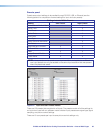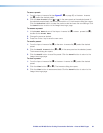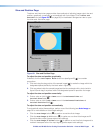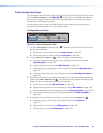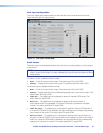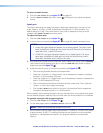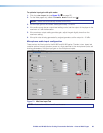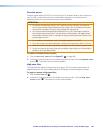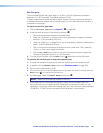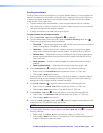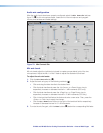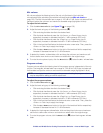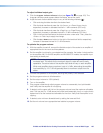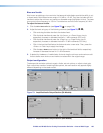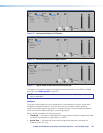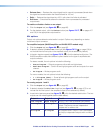
IN1606 and IN1608 Series Scaling Presentation Switcher • Internal Web Pages 101
Mic/line gain
The mic/line Gain fader has a gain range of -18 dB to +60 dB. Adjustments increase or
decrease in 0.1 dB increments. The default setting is 0.0 dB.
The gain range accommodates a line level signal, typically from line level source devices or
a wireless microphone receiver with a line level output, or a mic level signal from dynamic or
condenser microphones.
To adjust the mic/line gain fader:
1. Click the Mic/Line Input tab (see figure 71,
1
on page 99).
2. Adjust the level using any of the following methods (
-
):
• Click and drag the fader handle to the desired level.
• Press the <Up Arrow> or <Down Arrow> key to respectively increase or decrease
the level in 1 dB increments (PCS only).
• Press the <Page Up> or <Page Down> key to respectively increase or decrease the
level in 10 dB increments (PCS only).
• Click in the level text field below the fader and enter a new value. Then, press the
<Enter> or <Tab> key to apply the change.
• Click the Up or Down arrow button to the right of the level text field to respectively
increase or decrease the level in 0.1 dB increments.
3. To mute the mic/line gain, click the Mute button (
=
) below the mic/line Gain fader.
To optimize the mic/line gain on each microphone input:
1. Connect the desired microphone and route the mic/line input to the desired output.
2. If needed, click the Phantom Power button (see Phantom power on page 100).
3. Set the mic/line Gain fader to 0 dB.
4. If the mic/line input is muted (the Mute button is red when the audio is muted), click the
Mute button (
=
) to unmute the mic/line input.
5. For Web pages, select the Enable Meters check box (
~
).
NOTE: Meters are automatically enabled in the PCS.
6. While speaking into a connected microphone, adjust the mic/line Gain fader until
the mic/line audio input is clearly audible. Voice levels at microphone inputs can vary
significantly, so gain and meter level readings may vary. Aim to have the meter averaging
-20 dBFS to -15 dBFS to accommodate normal variances in voice intensity.



